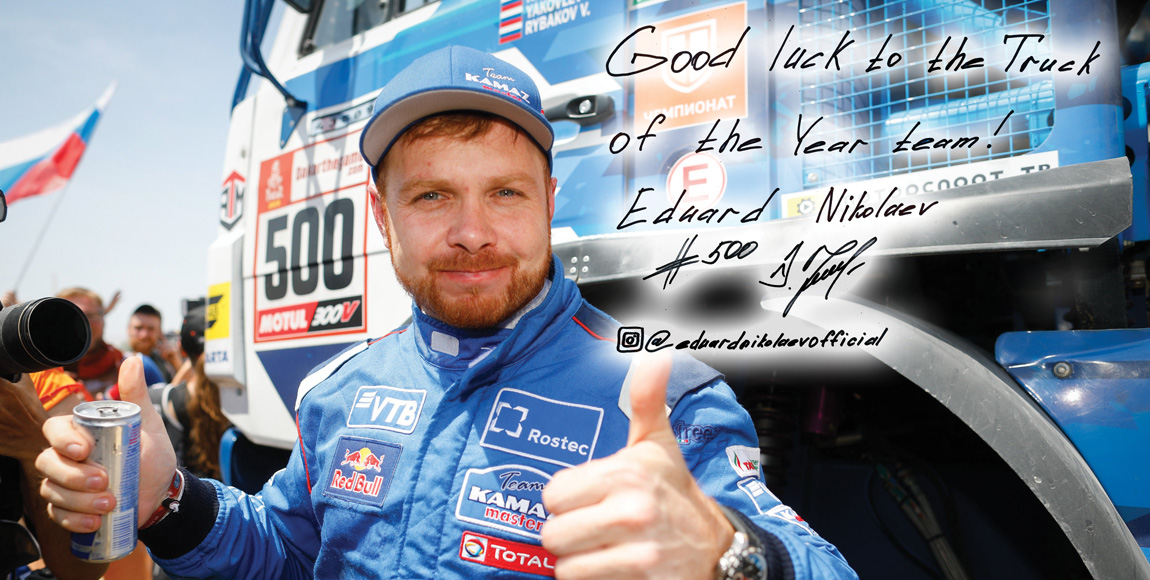Kamaz hits a hattrick!

GIANENRICO GRIFFINI has an exclusive interview with Eduard Nikolaev of the Kamaz Master Team, winner of the 2019 Dakar Rally trucks category
Nikolaev and the Kamaz Master Team have enjoyed three victories in a row in the toughest rally in the world. That’s no mean feat! How did the team manage it?
What was the secret to your performance this year? Your driving style and strategy? Your crew? The entire Kamaz team? Your truck? Was it a mix of all these factors?
First of all, this is a victory for the team. Our result came thanks to the team and thanks to our team leader, Vladimir Chagin, who devotes a lot of time to the race and imparts his skills to us. And, certainly, much depends on the vehicles.
This year we were driving new trucks, with new engines that proved themselves. Reliability of the vehicles, the team, as well as team experience are the components of success.
Dakar 2019 was a Peruvian “special”. Did you change your driving style in any way to compensate for this different format?
Although we already got to the Peruvian sands last year, the organisers somehow bypassed the dunes that were part of it this year. It was the first time I encountered the complexity of the dunes, so, for me, this Dakar was very difficult.
The experience that we have in driving on the sands certainly helped but, this year when I was driving through the dunes, I realised that it was a miracle I didn’t get stuck somewhere … it was very difficult. I have never driven on such sand in my career.
I would like to find similar conditions somewhere to train further; I feel that I still have not worked out this type of sand and I need to drive on it more.
Tell us about your Dakar this year. What else made it more difficult than last year?
The difficulty was that we started first and already at the first special stage saw the armada of competitors behind us, who wanted to catch up and overtake with each kilometre. It was difficult to hold our position.
Last year I also started first, but I had the third-best result after the first section, and this year I managed to lead on the first two special stages – which was not easy.
The dunes were unpredictable. Usually, when analysing the special stages after the evening briefing, we imagine the next day – the difficulty of it, the obstacles that it will hold. This year, however, there were dunes that, even on short sections, could throw out traps that one could not even pre-empt. Indeed, one could get caught in them and waste a lot of time.
The race was also shorter this year, though you can’t say that it was very short – ten days, 3 000 km of special stages – 10 km of driving on the sand felt equal to 300 to 400 km of hard roads. The average speed was low; if you look at how long we drove on the special stage of 250 to 280 km, then certainly the result would not even come close to driving on hard tracks. On these short days, the table could easily change from losing to winning.

Did you ever feel “alone” in the rally this year, because your teammates Ayrat Mardeev and Andrey Karginov had to abandon the competition?
Of course I missed the support of the guys. With two trucks abandoned, it seriously affected our strategy; it was harder.
We had heart-pounding, emotional moments when we really lost time. I think that if the team had been complete, then much of it could have been avoided and the fans and the team management would not have worried so much.
What did you think when you found your truck stuck in the sand during the Stage 8 special? Did you lose hope for victory in Lima?
No, as I said, 100 km of dunes can change the whole race. I realised how much I had lost and how much time I still had, but I didn’t focus on it, I just did my job. I try to never think about time, just what is required of me on a special stage.
Yes, I did my best to get out of the jam. We gave it 100 percent and continued to go to the finish, while adding pace, of course. We had to take some risks, because we realised that the time was lost, but it was a necessity and I think justified to try to win back a little time.
The situation was not simple; it was the first time in my career I got stuck like that. Some of our teammates faced similar situations in Africa, but this was a first for me. I am grateful to the whole crew that we could dig ourselves out quickly, and that we made the right decision.
Would you like to race in a bonneted truck in the future? Have you ever tried one?
Bonneted trucks are very interesting. I am glad that our crew managed to participate in constructing of the first bonneted truck for the team and test it. The truck performed very well.
This is our next step and our future. The bonneted truck allows one to go faster in any conditions; from sand, to winding tracks and off road.
As Kamaz celebrates its 50th anniversary this year, what does this Dakar success mean?
We really wanted to achieve this result and dedicate it to the 50th anniversary of Kamaz. It is a great honour for us. We wanted the victory to be a gift for the anniversary, I’m glad that we managed it.
SA-built Hilux wins Dakar 2019!
The number 301 Toyota Gazoo Racing SA Toyota Hilux of Nasser Al Attiyah and Mathieu Baumel took overall honours at the 2019 Dakar Rally bringing home the first-ever Dakar Rally victory for Toyota.
“We are so happy to win the Dakar – not only for ourselves, but also for Toyota and the entire Toyota Gazoo Racing SA team. Everyone has worked so hard for so long, and really deserves this. Thank you for letting us drive this car,” the race winner said.

Al Attiyah/Baumel and teammates South African Giniel de Villiers and Dirk von Zitzewitz, in the number 302 Hilux, completed the final stage of the rally together. With the stage having been started in reverse order, De Villiers/Von Zitzewitz pulled out their deck chairs (literally) and waited nearly 55 minutes for the leaders to start the stage, in order to shadow them to the finish.
De Villiers’s hopes of another Dakar win (his previous being in 2009) were dashed early on when his Hilux suffered serious damage after hitting a hidden rock. He showed his class, however, and managed to pilot the 302 Hilux up to a top-ten finish, ending the 2019 event in ninth place, 7:59:16 behind the overall winner.
“Obviously we came here to try to win the race,” said De Villiers, who actually lost a place in the overall rankings during the 55-minute wait. “Once that dream ended, we were happy to support Nasser and Mathieu’s effort. If we couldn’t win it ourselves, the next best thing was for one of our teammates to take the victory, and I am overjoyed at the final result.”
Full of emotion, team principal Glyn Hall commented that the victory was long overdue. “Winning the Dakar is never easy – there are a lot of people trying. This year’s race was no exception, and brought a rollercoaster of emotions and results for the team.”
Published by
Focus on Transport
focusmagsa




